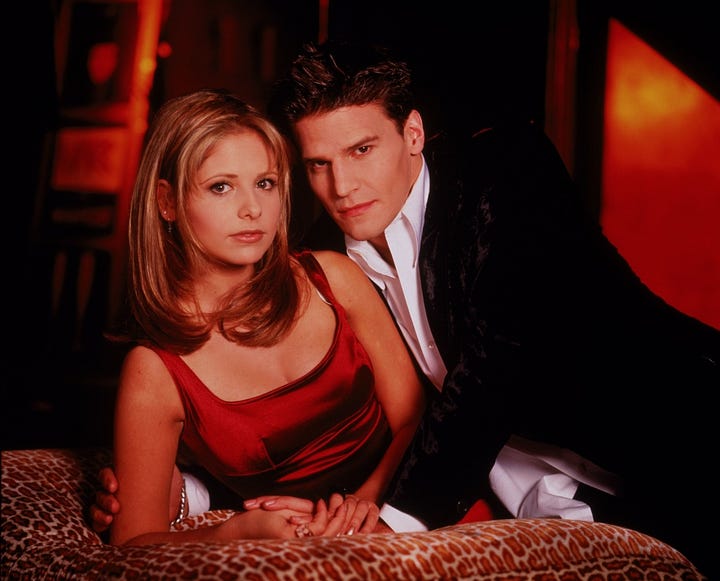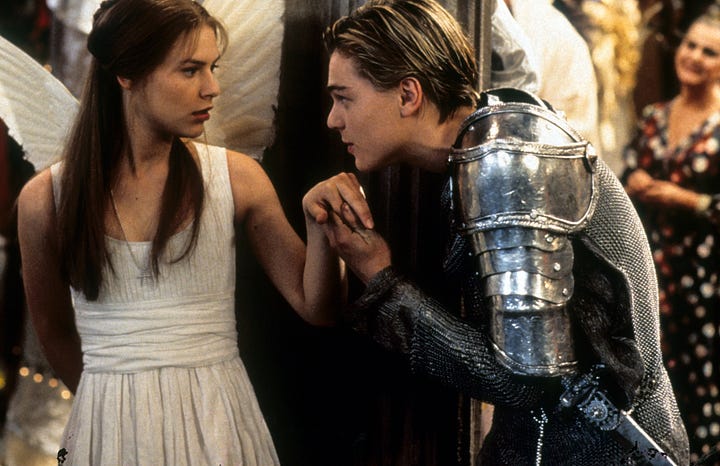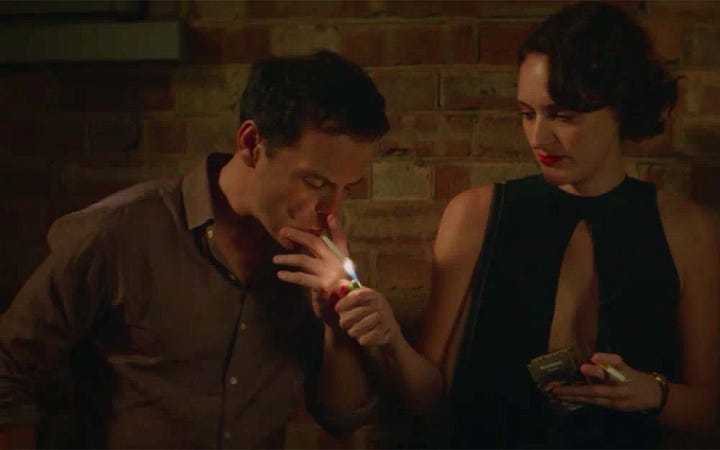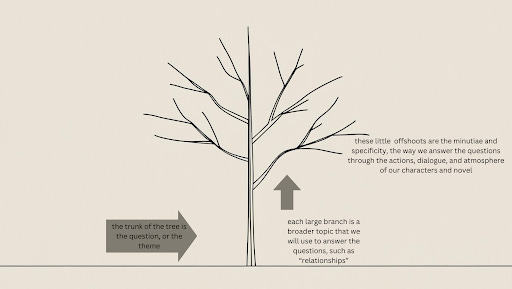Using Theme and Conflict to Supercharge Romantic Pairings
Mini Masterclass — a new monthly series!
Mini Masterclass is a bite-sized monthly column by Erin Karbuczky for writers hungry to deepen their craft, shift perspective, and try something new. Each installment offers an actionable lesson—grounded in real examples and fresh thinking—from the worlds of fiction, memoir, poetry, pop culture, and beyond.
Writing a novel, novella, or other large body of work can be intimidating even if you’ve done it before. In addition to the plot, characters, and setting, there is structure, theme, and conflict - ah, conflict, like throwing knives at your precious angel baby characters you would likely prefer to coddle.
So how do we give our characters conflict and obstacles that feels meaningful to the story, while also tying it all up neatly with a theme?
Using examples from Buffy, Pushing Daisies, Fleabag, and Romeo and Juliet, I will guide you through using theme and conflict to make an outline that will help you stay focused and make sure you are building the strongest possible story. For now, we will focus mainly on using those elements to make your romantic subplot work in service of the rest of the story.




Your favorite TV or book pairings are never just there for decoration. Buffy and Angel, Chuck and Ned from Pushing Daisies, Fleabag and the Priest, Romeo and Juliet - what makes us “eat up” these love stories? There is almost something narcotic about the hold they have on us, and many of us dream of writing our own pairing that will hook an audience like the above. My hypothesis is that the love we have for these pairs and others is a result of a promising premise (which contains juicy conflicts) and the theme of the work as a whole.
The first thing we need to do is talk about how to infuse theme throughout your work intentionally.
If you want your writing to sparkle and stand out, one of the best things you can do is go into the writing process knowing your theme. One advantage of going in knowing the theme is being purposeful from the very beginning (as most of what happens will be in service of the theme). Although things will evolve over time and drafts, your future self will very much appreciate your past self’s forethought.
For some, the theme comes easily. For others, it’s an accident that forms while writing. And still, for others, it can feel so daunting and looming.
How can you create theme in your novel on purpose?
Let us discuss what theme is: theme is the central question within your novel that is answered over and over through various perspectives and moments.
Theme can also be within a body of work rather than just a novel. Think about your favorite authors, the ones you read every book they write. I would wager that most of them keep coming back to similar themes throughout each novel, eventually putting all of their work in conversation with itself, until it is like a kaleidoscope of opinions and thoughts and points of view.
The best “how to” breakdown of theme I’ve ever seen comes from thriller author Danielle Valentine. (She wrote the novel Delicate Condition which was used as the inspiration for a recent season of American Horror Story.) In her video here, she says that in order to write theme for your novel, you must first pose a question to yourself. For example, “How much suffering must a woman endure to become a mother?” Then, you spend the rest of your novel or piece answering that question through your narrative including through your conflict and characters.
I spent a lot of time talking about how this works, and giving some great examples, here: Mini Writing Masterclass: The Art of Weaving Themes, Symbols, and Motifs in Fiction. I highly recommend you read it if you can, as a companion piece to this one.
Why bother knowing your theme so early in the process?
Because if you know the question(s) you want to answer, and you know the potential answers you want to explore, this will help you decide:
The kind of characters needed
The situations you need to put them in
And even the settings you need to utilize
Everything will begin to fall into place like dominoes.
How do conflict and theme tie together?
As writers we use many literary devices simultaneously without even knowing it. Here is a chance to be more conscientious with our work: use conflict in your novel to illustrate the theme over and over to create a more well-rounded story.
Think of conflict and theme like a tree. The trunk of the tree is the theme. Then, there are large branches of conflict or obstacles that shoot off of the trunk. Each branch has multiple little offshoots - every time your characters try to find solutions, more problems arise. Not all conflicts must be resolved at the end, but if you close up the big conflicts, a lot of the little conflicts will close as well.
So you ask a question, and you answer it through conflict via behavior and choices of your main characters.
Here are a few examples:
Sample question: How far will society go to crucify women who make their own decisions beyond what is considered “mainstream” in our society?
The big branches coming off the tree might be career, marriage, family planning (including childfree), and faith (including atheism).
The little branches coming off each big branch can represent the situations thrown at this character, the situations she gets into as a result of her choices that will move the plot forward, and characters who can interact with her and showcase their opposing POV, or reinforce hers. You can choose to include a character who DOES make “mainstream” decisions, maybe her mother, a friend, a coworker, as a foil.
Think about the book series If You Give a Mouse a Cookie.
The question is, “What happens if you give a mouse a cookie?”
And each big branch is the “then” in “if… then.”
A final example before we get into our tv shows: the big question could be, “How does going through a [specific historical event] change a person?” The branches are the parts of their life that will change, such as relationships with family members, maybe grief if they survive something a loved one doesn’t, and so on. The trick is to start broad and general and then narrow down to the specifics.
Let’s demonstrate with our familiar couples
Buffy the Vampire Slayer
The question being asked: “What if we put the weight of continuously saving the world from supernatural forces on a teenage girl?”
Couple: Buffy and Angel (Spuffy shipper? PROMPT: Make your own conflict tree for Buffy and Spike!)
The category “relationships” would be a big branch on the conflict tree of Buffy (who wants more than anything to be a normal teenage girl!). Then you’d have offshoots from that branch: relationship with her mother, relationship with her friends, love interests. And an offshoot of the love interest branch would obviously be Angel. Their relationship brings a lot of conflict throughout the first few seasons especially, giving way to the bigger story: Buffy can never be a normal girl, with a normal relationship and afterschool job. Buffy is the slayer. And that ripples throughout her entire life. Here are some of the little branch labels:
Buffy is a vampire slayer and Angel is a vampire with a soul.
They fall in love.
But there is a curse on Angel - if he experiences a single moment of pure happiness, he will lose his soul. When he and Buffy have sex for the first time, this happens.
Now he is on the warpath, killing and maiming gleefully. Buffy still loves him, but she has to make a choice - kill him or let him kill everyone she loves (and innocent people in the world at large), before killing her.
Even if he gets his soul back, they can never have a normal relationship that she desires and deserves.
So Buffy must make the heartbreaking, but necessary, decision to kill him - because she cannot be a selfish teenager. She must save the world.
Pushing Daisies
The question being asked: “What if a man can bring the dead back to life with a single touch, but by doing so, something else must die?”
Couple: Chuck and Ned
While the question would be the trunk, once again one of the branches coming off the trunk would signify “relationships.” Ned’s secret ripples throughout his entire life. Like Buffy, he uses his powers to solve crimes and mysteries. And like Buffy, what makes him unique also needs to be kept hidden, which makes it hard for him to find love and intimacy of any kind.
To complicate matters, if Ned doesn’t put the person back to being dead again within a few minutes, someone or something else will die (and he can’t control what or who). So when Ned brings back a woman he knows from his past, and can’t bear to see her die again, this complicates things. And when they start to fall in love, he isn’t able to kiss her, hold her, or dance with her, or she will die again and be lost forever (he isn’t able to just continuously reanimate her). So here are some of the branches on Ned’s conflict tree.
He has the ability to bring the dead back to life with a single touch, but once he touches them again, they die forever
If he keeps someone/something alive for more than a minute, another life is lost. Therefore, he can only bring someone back for one minute, or face consequences
He brings his former childhood friend back and can’t bear to put her back dead
Therefore, he sacrifices another life (killing innocent strangers)
If he touches Chuck again, she will die for real. But they are in love, and it is almost impossible to not touch. They must find ways to be connected to each other that aren’t about touch, or allow them a loophole of some kind.
This complicates their relationship because they both deserve to be with someone who they can be intimate with as that is something they both crave, especially Chuck.
And because she is “dead,” they have to keep their relationship secret. If this was your conflict tree, think, what are the consequences of keeping a relationship secret? Perhaps estrangement or distance from loved ones. Perhaps conflict within the relationship itself if one of the pair doesn’t want to be so secretive. And who can find out about the relationship and threaten to reveal it?
Another conflict for Chuck is that the aunts that raised her are beloved by her, but she cannot tell them she’s okay - their grief is palpable.
Fleabag
The question being asked: Does a love story need a happy ending?
Couple: Fleabag and the Priest
The main conflict of their relationship is that the priest has spent so much time getting his life together, has chosen his vocation as a way to keep himself together, and if he gets together with Fleabag not only will that unravel his vocation, but doing so will unravel his entire life. His commitment to his faith is the reason he stays sober, and his sobriety is the reason he is still alive, and connected to his family. This obstacle is incredible because it is multiple obstacles in one.
Here are some of their branches:
They fall in love, except his love for her threatens his relationship with God.
Which in turn threatens his relationship with his sobriety/abstinence
This is the path he knows he must stay on, but he is falling in love with her, and doesn’t want to break her heart or see her hurt, especially because he can see a future with her.
Being with her would be courting his own destruction, so they must part, knowing the pain of true love that cannot be, both forever changed.
Romeo and Juliet
The question being asked: “What if two young people from rival families fall in love?”
Couple: Romeo and Juliet (okay, not a TV couple, but a universally known couple)
I think we know this one!
They come from rival families
She is engaged/betrothed to Paris
Marriage at this time is an arrangement for financial purposes. This would take apart an alliance between families, not just break up a couple.
They’re too young to make their own decisions
Juliet is not really a person, she is a female child, and therefore considered property, so she may never be allowed to make decisions
They have to come up with a secret plan/exile
Solution - working with Maid and Priest
Their wires get crossed on the poison
When Romeo believes Juliet to be dead, he kills himself, and when she sees this, she takes poison, because she can not go back to the way her life was before.
Other couples left on the cutting room floor include Queen Charlotte and King George III from Bridgerton and Addie and Luc from The Invisible Life of Addie LaRue. Who would you add to the list?
Once you have your theme picked and your conflicts big and small, you can also start to think about symbols and motifs, also expanded upon in another of my previous articles for Write or Die. For a quick and dirty explanation:
Symbols and motifs are theme’s little sisters. A symbol is an object, sound, person, or the like, that “means” something within the text. So you can decide on a few symbols and/or let them come up organically for you. For a basic example, flowers can symbolize sexuality. Fire can symbolize passion. Of course, you make your own symbols. When you use a symbol intentionally, and continuously, it becomes a motif.
Think: Gatsby and Daisy’s green light as a symbol of hope, or the pickles and donuts in Ethan Frome.
PS - another great time in the writing process to use this method is between your first and second drafts, to make sure your story is strong and going in the right direction for your intentions.
Comment below with any questions, ah-ha moments, or let us know if you used this method and what you thought!
What is the question at the center of your current or future WIP?
How can this question be answered by the actions of your main and secondary characters?
What are 5-10 couples (or platonic friends!) you love in tv/movies/books?
What are the conflicts at the center of their relationship?
How can you draw inspiration from those conflicts to create your own?
Make a list of 5-10 conflicts you can use in your own work, including (if applicable) reframing the conflict/theme in your current WIP
Now take the conflict from your WIP/one of your favorites from the list, and think about:
How does this conflict extend throughout the story as a whole?/ What is the ripple effect?
How does the conflict cause the characters to behave?
What symbols and motifs might you include to drive the point home?








Great primer on theme! Taking notes!
Buffy!! <3